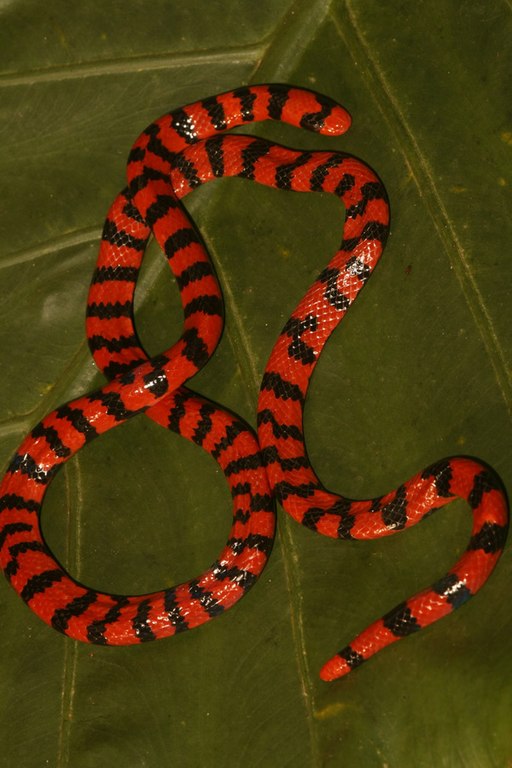Superregnum: Eukaryota
Regnum: Animalia
Subregnum: Eumetazoa
Cladus: Bilateria
Cladus: Nephrozoa
Superphylum: Deuterostomia
Phylum: Chordata
Cladus: Craniata
Subphylum: Vertebrata
Infraphylum: Gnathostomata
Superclassis: Tetrapoda
Cladus: Reptiliomorpha
Cladus: Amniota
Classis: Reptilia
Cladus: Eureptilia
Cladus: Romeriida
Subclassis: Diapsida
Cladus: Sauria
Infraclassis: Lepidosauromorpha
Superordo: Lepidosauria
Ordo: Squamata
Subordo: Serpentes
Infraordo: Alethinophidia
Superfamilia: Anilioidea
Familia: Aniliidae
Genus: Anilius
Species: Anilius scytale
Subspecies: A. s. phelpsorum – A. s. scytale
Name
Anilius scytale (Linnaeus, 1758)
Original combination: Anguis scytale
References
Linnaeus, C. 1758. Systema Naturae per regna tria naturæ, secundum classes, ordines, genera, species, cum characteribus, differentiis, synonymis, locis, Tomus I. Editio decima, reformata. Holmiæ: impensis direct. Laurentii Salvii. i–ii, 1–824 pp DOI: 10.5962/bhl.title.542: 228. Reference page.
Anilius scytale at the New Reptile Database
Vernacular names
català: Anílid
čeština: Vinejš červený
Deutsch: Korallenrollschlange
English: Burrowing False Coral, Red Pipe Snake, False Coral Snake, Coral Cylinder Snake
suomi: Koralliluikertaja
magyar: Kétfejű csavarodósikló
Nederlands: Onechte koraalslang
norsk: Falsk korallslange
polski: Cylindrowcowate
русский: Коралловая сверташка
slovenčina: Zvíjavcovité
svenska: Falsk korallorm
ไทย: งูปะการังแปลง, งูท่อ
українська: Валикова змія коралова
中文: 筒蛇
The Aniliidae are a monotypic family[2] created for the monotypic genus Anilius[3] that contains the single species A. scytale.[4] Common names include American pipe snake and false coral snake.[2] It is found in South America. This snake possesses a vestigial pelvic girdle that is visible as a pair of cloacal spurs. It is ovoviviparous. It is non-venomous, and its diet consists mainly of amphibians and other reptiles. Currently, two subspecies are recognized, including the typical form described here.[4]
Description
Spectacled caiman and false coral snake by Maria Sibylla Merian
This species is found in the Amazon rainforest of South America, the Guianas, and Trinidad and Tobago. It is a moderate-sized snake attaining a size of about 70 cm (28 in) in length. It is reported to be ovoviviparous and feeds on beetles, caecilians (burrowing amphibians), amphisbaenids (legless lizards), small fossorial snakes, fish, and frogs. It has a cylindrical body of uniform diameter and a very short tail; it is brightly banded in red and black and reduced eyes lie beneath large head scales. It is considered to be the snake that most resembles the original and ancestral snake condition, such as a lizard-like skull.[5]
Geographic range
They are found in the tropics of northern South America from southern and eastern Venezuela, Guyana, Suriname and French Guiana south through the Amazon Basin of Colombia, Ecuador, Peru, and Brazil. The type locality given is "Indiis".[1]
Subspecies
Subspecies[4] Taxon author[4] Common name Geographic range
A. s. phelpsorum Roze, 1958
A. s. scytale (Linnaeus, 1758)
Taxonomy
Modern classifications restrict the family to the South American red pipe snake or false coral snake Anilius scytale, with the previously included Asian genus Cylindrophis raised to a separate family, Cylindrophiidae. Anilius is not closely related to Asian pipesnakes. Instead, its closest relatives appear to be the Neotropical Tropidophiidae.[6][7]
References
McDiarmid RW, Campbell JA, Touré T. 1999. Snake Species of the World: A Taxonomic and Geographic Reference, Volume 1. Washington, District of Columbia: Herpetologists' League. 511 pp. ISBN 1-893777-00-6 (series). ISBN 1-893777-01-4 (volume).
"Aniliidae". Integrated Taxonomic Information System. Retrieved 14 August 2007.
"Anilius". Integrated Taxonomic Information System. Retrieved 14 August 2007.
"Anilius scytale". Integrated Taxonomic Information System. Retrieved 14 August 2007.
Evolution – snake
Pyron, RA; Burbrink, FT; Wiens, JJ (2013). "A phylogeny and revised classification of Squamata, including 4161 species of lizards and snakes". BMC Evolutionary Biology. 13: 93. doi:10.1186/1471-2148-13-93. PMC 3682911. PMID 23627680.
Reynolds, RG; Niemiller, ML; Revell, LJ (2014). "Toward a Tree-of-Life for the boas and pythons: multilocus species-level phylogeny with unprecedented taxon sampling" (PDF). Molecular Phylogenetics and Evolution. 71: 201–213. doi:10.1016/j.ympev.2013.11.011. PMID 24315866. Archived from the original (PDF) on 2015-12-02. Retrieved 2018-05-14.
Further reading
Boos HEA. 2001. The Snakes of Trinidad and Tobago. College Station, Texas: Texas A&M University Press. ISBN 1-58544-116-3.
Martins M, Oliveira ME. 1999. Natural history of snakes in forests of the Manaus region, Central Amazonia, Brazil. Herpetological Natural History 6: 78-150. PDF.
Retrieved from "http://en.wikipedia.org/"
All text is available under the terms of the GNU Free Documentation License


